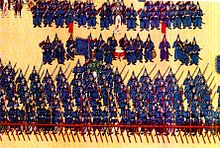Eight banners
In China of the Qing dynasty, the military and administrative units into which all Manchurian families were divided were referred to as eight banners ( Manch.: Gūsa , Chinese 八旗 , Pinyin bāqí ) .
Originally they were based purely on tribal affiliations, but soon acquired military significance, as each banner had to provide a certain number of troops. In this respect they were in competition with the Han Chinese -influenced Green Standard .
history

The banners were introduced at the beginning of the 17th century by the tribal prince Nurhaci , and later they were to become a mainstay of the Manchurian-Chinese Qing Empire . Originally 300 households belonged to one company. 5 of these were divided into a battalion and 10 battalions formed a banner. Originally divided into four banners, these were divided and doubled in 1615 with the creation of the framed banners.
Regardless of their military origin, the eight banners were also given civil duties. While initially five banners were subordinate to imperial princes, later all eight were under the direct control of the emperor. After the conquest of China in particular, the Manchurian banners became increasingly professional and bureaucratic.
Han Chinese and Mongols were also increasingly included in the banners. Around 1700 65% of all banner people were Han Chinese, 19% Mongols and only 16% Manchu, yet the latter group held 2/3 of all high state offices. Chinese not belonging to any banner were given administrative duties. If the banner soldiers were originally given a share of the booty by the Manchu leaders, they later received a fixed salary.
In addition to the Eight Banners of the Manchu, Huang Taiji had the Eight Banners of the Han Chinese erected in 1631 and the Eight Banners of the Mongols in 1635. The now actually twenty-four banners were still referred to collectively as the eight banners.
The largest and most important banner garrisons were in Beijing , Xi'an, and Hangzhou during the Qing Dynasty . Significant units were also stationed in Manchuria , Yunnan , along the Yangtze River and on the Imperial Canal . The associations were structured hierarchically: the smallest unit was the 300-man niru ( Chinese 佐領 , pinyin zuǒlǐng ). Above it was the jalan ( Chinese 參 領 , pinyin cānlǐng ) comprising 5 niru . Finally, 5 jalan formed a banner ( gūsa ; Chinese 旗 , pinyin qí ). These are of course only guidelines, from which it was possible to deviate in practice.
In the course of time, numerous Chinese and Mongolian banner units were returned to civil status or integrated into the Army of the Green Standard. At the end of the Qing Dynasty, all members of the Eight Banners were considered Manchus by the Republic of China, regardless of ethnicity .
Still an effective military instrument during the conquest of China in the 17th century, the banners gradually fell into disrepair. During the Opium Wars and Taiping Rising, they were found to be unsuitable for modern 19th century warfare. Accordingly, the Qing emperors began to create a new army of western style. Nevertheless, the banner system existed until the fall of the dynasty in 1911.
The eight banners
| banner | German | Manchurian | Chinese | position | Known relatives |
|---|---|---|---|---|---|

|
Framed yellow banner |
ᡴᡠᠪᡝᡥᡝ ᡧᡠᠸᠠᠶᠠᠨ ᡤᡡᠰᠠ kubuhe suwayan i gūsa |
鑲黃旗 Xiānghuáng Qí |
Leader of the eight banners, first of the "top three banners" | Cixi (originally Framed Blue Banner, later added here), Oboi |

|
Yellow banner |
ᡤᡠᠯᡠ ᡧᡠᠸᠠᠶᠠᠨ ᡤᡡᠰᠠ gulu suwayan i gūsa |
正 黃旗 Zhènghuáng Qí |
one of the "top three banners", quantitatively the strongest of the eight banners | Sonin , Mingzhu |

|
White banner |
ᡤᡠᠯᡠ ᡧᠠᠩᡤᡳᠶᠠᠨ ᡤᡡᠰᠠ gulu šanggiyan i gūsa |
正 白旗 Zhengbái Qí |
one of the "top three banners" | Cao Xueqin , Dorgon , Ronglu , Gobulo Wanrong |

|
Red banner |
ᡤᡠᠯᡠ ᡶᡠᠯᡤᡳᠶᠠᠨ ᡤᡡᠰᠠ gulu fulgiyan i gūsa |
正 紅旗 Zhenghóng Qí |
first of the "lower five banners" | Daišan , Heshen , Lao She |

|
Framed white banner |
ᡴᡠᠪᡠᡥᡝ ᡧᠠᠩᡤᡳᠶᠠᠨ ᡤᡡᠰᠠ kubuhe šanggiyan i gūsa |
鑲 白旗 Xiāngbái Qí |
one of the "lower five banners" | Agui (阿桂), Aisin Gioro Xianyu |

|
Framed red banner |
ᡴᡠᠪᡠᡥᡝ ᡧᠠᠩᡤᡳᠶᠠᠨ ᡤᡡᠰᠠ kubuhe fulgiyan i gūsa |
鑲 紅旗 Xiānghóng Qí |
one of the "lower five banners" | - |
| Blue banner |
ᡤᡠᠯᡠ ᠯᠠᠮᡠᠨ ᡤᡡᠰᠠ gulu lamun i gūsa |
正 藍旗 Zhenglán Qí |
originally one of the "top three banners", demoted to the "bottom five" when the white banner was added to the "top three" | Keying , Qigong , Zhao Erxun , Zhao Erfang | |

|
Framed blue banner |
ᡴᡠᠪᡠᡥᡝ ᠯᠠᠮᡠᠨ ᡤᡡᠰᠠ kubuhe lamun i gūsa |
鑲 藍旗 Xiānglán Qí |
one of the "lower five banners" | Cixi (born in this banner, later included in the Framed Yellow Banner), Jirgalang , Ortai |
See also
literature
- Jonathan D. Spence: China's Path to Modernity. Updated and expanded edition. Deutscher Taschenbuch-Verlag, Munich 2001, ISBN 3-423-30795-1 ( dtv 30795).

